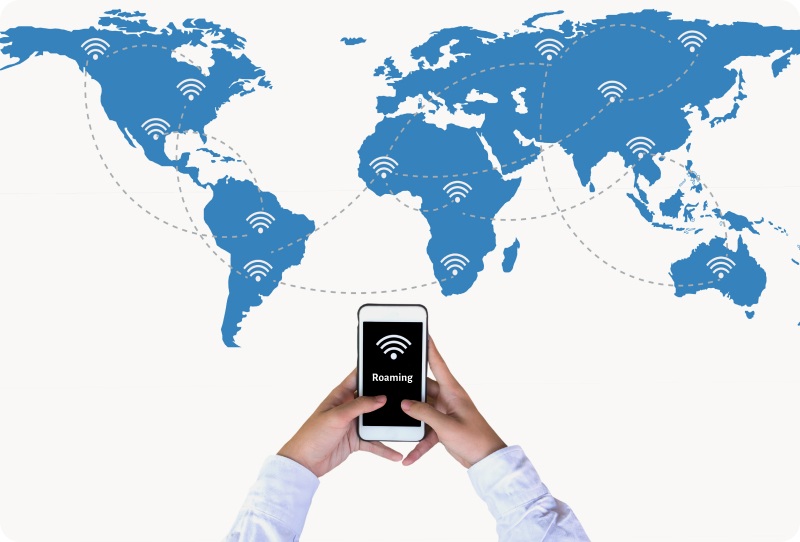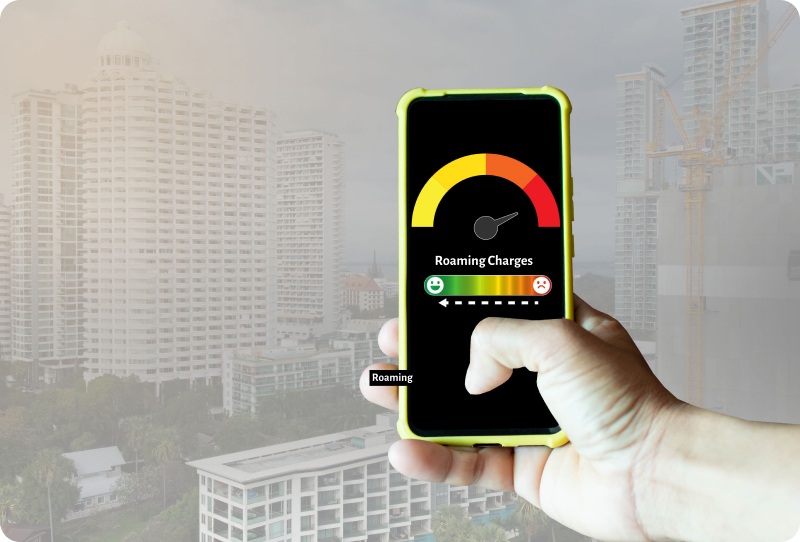
We all have heard the term roaming, right? But with mobile connectivity becoming increasingly global, it’s more important than ever for both telcos and travelers to understand how data roaming works.
What is Data Roaming?
Data roaming is the technology that lets travelers access mobile internet services such as calls, texts, and internet usage when they are outside their home network connectivity, typically in a different country.
If you have been an international traveler sometime, then you must have found yourself roaming. For example, you are from Japan but visiting Germany. As soon as you land in Germany, your phone automatically connects to a carrier in Germany. This means instead of losing connectivity, your device connects to a local network partner in Germany, enabling you to continue using mobile services such as checking emails, browsing Google Maps, and uploading stories on social media platforms.
Different Types of Roaming

We just learnt that roaming is about using your phone in another country. But wait, there are several types of roaming that travelers might not even realize they are using. Let’s explore its different types:
1. National Roaming
As the name suggests, national roaming occurs within the same country but across different operators. For example, if you’re a BSNL user in a remote area with no BSNL coverage in India, your phone might temporarily switch to Vodafone’s network.
2. International Roaming
Again, the term indicates that international roaming happens when you travel abroad and connect to a foreign mobile network. For example, a Verizon user in the U.S. roaming on a Vodafone network while visiting the UK.
3. Permanent Roaming
Permanent roaming is intended for devices, like IoT sensors or M2M SIMs, smart meters, that remain permanently in a foreign country but continue using a SIM from the original country, typically for more than a month or two. These devices rely on permanent roaming to maintain connectivity across borders. This type of roaming is often used in global logistics or fleet tracking.
4. Data-Only Roaming
Also called mobile data roaming, in this type of roaming, only data services (not voice/SMS) are enabled when a traveler is outside their home network coverage area. For example, tourists using eSIMs focused on internet-only packages.
It is important to note that both national and international roaming are used temporarily, such as tourists on vacation, business travelers visiting abroad for meetings, etc.
Why Do You Need Data Roaming?
To understand the need for data roaming, let’s use an example. Suppose you land in a new country and are instantly able to check Google Maps, reply to your office emails, and share a quick airport selfie with your family and friends – all without scrambling for a local SIM card. That’s the power of data roaming.

In other words, you need data roaming because you need to stay connected when you are travelling, which means you are away from your home network. Data roaming makes sure that you are never offline when you are away from your home network. Some of the most useful stuff data roaming helps you with include:
- Explore unfamiliar locations using navigation apps
- Stay in touch with clients and colleagues using email and messaging
- Share your real-time location and activities via social media updates
- Make hotel bookings and schedule rides using appropriate apps.
In short, we can say that data roaming provides you a hassle-free way to stay connected anywhere in the world, without swapping SIM cards.
Weighing the pros and cons of anything helps us better set our expectations. Let’s quickly evaluate the ups and downs of data roaming.
Pros of Data Roaming
-
Instant Connectivity
What’s the first thing when you land in a foreign country? For most people, it is letting their family know that they arrived safely. Data roaming lets you do this without needing you to hunt for WiFi or buy a local SIM card. It automatically connects your phone to a local carrier, and within seconds, you are online.
-
Convenience at its Best
Every service that runs on your phone works just the same when you use data roaming. You don’t need to set up a new phone number or update your colleagues and friends. What a convenience, isn’t it?
-
Ideal for Short Trips
Suppose you are on a weekend trip to another country for vacation or business purposes. For such short-duration trips, data roaming appears to be a great option because it saves you a lot of time and effort that would otherwise be consumed in switching to a local SIM card or service. It’s more practical, especially when you are already juggling travel schedules.
Cons of Data Roaming
-
It Can Be Pricey
Most of the travelers need to stream videos, navigate maps, download files, and use data for other services. However, roaming charges can add up quickly, leading to bill shocks if you don’t monitor your usage.
-
Limited Data Allowance
If you are using a roaming pack, then it usually offers limited data. Once you cross the threshold, you may experience a downgrade in speed. This means that your video calls might slow down mid-usage.
-
Privacy Concerns
While roaming, your phone might connect to unfamiliar networks, which may raise security concerns. If the mobile network you are connected to is not properly encrypted, then it might be vulnerable to attacks.
Key Components of Data Roaming

While data roaming offers a lot of convenience, it is no magic; rather, several behind-the-scenes elements work together to keep you connected. Let’s break down these elements, one by one:
1. Your Home Network Provider or HPMN
This is the network provider to whom you pay your phone bill. HPMN or Home Public Mobile Network is your main mobile service provider that manages your SIM card, your phone number, and all the mobile services, even when you are on international travel. The job of identification, authentication and data usage is also performed by HPMN.
For example, you live in the U.S., using T-Mobile services, and are traveling to Germany, then T-Mobile is your home network.
2. The Visited Network or VPMN
In the above example, when you travel to Germany, your mobile phone roaming connects you to a local network provider in Germany, such as Vodafone Germany – this will be your visited network.
VPMN, or Visited Public Mobile Network, is the network to which your mobile phone connects temporarily when you are abroad. Since your HPMN or home network doesn’t operate in every country, it teams up with local operators in those countries to allow roaming for its subscribers.
3. Roaming Agreements
Your home network provider and the visited network provider sign roaming agreements to define the access rules, quality of service, pricing for the services, etc. As per the above examples, T-Mobile and Vodafone Germany have roaming agreements that let T-Mobile users access the Vodafone network when they visit Germany.
4. Data Clearing House
International roaming is a complex process, and the presence of someone who can ensure the accuracy and efficiency of the entire process of billing and setting roaming charges. Data clearing house is a third-party company that calculates the data usage and defines what’s owed between networks, and manages the exchange. You can imagine it like a central accountant for the telcos.
5. IPX and GRX Networks
These are private, high-speed roaming data pipelines that make sure that when data travels across borders between operators, it is transmitted securely and swiftly. While GRX or the GPRS Roaming Exchange handles the basic internet connections, IPX or IP Packet Exchange is a modern solution for secure voice, data, and messaging.
Isn’t it amazing that while you simply scroll through your Facebook feed when you are abroad, an entire global infrastructure sits quietly behind the scenes and makes things possible quickly.
How Does Data Roaming Work Technically?
Now that we have learnt about the various elements that are involved in the process of data roaming, it would be easier to understand how the process flows technically.
As soon as you land in a new country and switch off the airplane mode:
- Your phone starts searching for signals and reaches out to local networks or VPMNs. It then sends a request to connect to a local network.
- Upon receiving the request, the local network first authenticates you. It checks for your authenticity with your home network or HPMN. Your home network validates your SIM credentials and roaming settings and sends a green signal to VPMN.
- Once authenticated, data sessions are routed through GRX/ IPX networks. One important thing to remember here is that the data isn’t just floating around in the local network; rather, it is securely routed back to the home network through GRX and IPX.
- All your internet usage is logged and billed through roaming data records (CDRs).
Why are Data Roaming Charges High?
For most of the travelers, checking their phone bills after an international trip is nothing less than a nightmare. The high cost of roaming charges often makes travelers feel like they have spent a fortune for just scrolling a their social media feeds and making a few calls when they were abroad.

If you, too, are wondering about what makes roaming so expensive, then let’s break it down into simple words:
1. Inter-Operator Fees
Connecting to a local network in a foreign land and using their services is like borrowing a network. The visited network won’t let you use their services for free, right? Every time you make a call, send a text, or use data, the VPMN charges your HPMN a certain amount of fee as defined in the roaming agreement between them.
2. Infrastructure Costs
Setting up and maintaining international tunnels or the IPX networks is an expensive process. Operators have to invest heavily in specialized equipment, secure data routing, and global infrastructure that ensures the seamless and secure transmission of data across borders.
3. Limited Competition
There are only a few options in terms of local networks to which you can connect when you are roaming in a different country. This is because your home network provider has agreements with one or two local carriers. In a situation where there is less competition, the rates for roaming become higher with limited room for negotiation. Suppose you are extremely hungry and there is only one food stall at that place. Buying a $10 banana in such a situation would suddenly make sense, right?
4. Complex Usage Monitoring & Billing
When using mobile services while roaming, the usage needs to be tracked, logged, and billed across two different systems, and that too in real-time. It’s simply not a straightforward process – the VPMN and HPMN require thorough coordination to share records, reconcile usage, and calculate charges. This backend work again adds to the roaming costs, which are passed on to you.
In short, we can say that travelers who use roaming services do not just pay for the data; rather, they pay for the access, the transit, secure infrastructure, and all the work that is being done behind the scenes.
How to Control Data Roaming Costs?

When it comes to the high cost of data roaming, the goal for both travelers and telcos is the same: to control data roaming charges. We are listing some smart ways that can help.
For Travellers
-
Use local SIM cards or travel eSIMs
The moment you land in another country, you can consider buying a local SIM card or activating a travel eSIM. Instead of paying your home network hefty roaming fees, you can grab a local SIM card with a few GB of data for $20. eSIMs are even more convenient—simply scan and activate.
-
Turn off background data or use Data Saver mode
Most people don’t know how much data their phone consumes in the background, even when not in use. Therefore, it’s a good idea to turn on data saver mode when roaming to keep this in check. Doing so will restrict non-essential apps from chewing up your data in the background.
-
Buy International Roaming Packs from Your Provider
A wise way to save on your roaming charges is to check your mobile service provider for roaming packages. While you may have to pay $5/ MB for pay-as-you-go roaming, a package may let you use the same amount of data at a much lower price.
-
Use Wi-Fi where possible
This one is quite straightforward. You can find WiFi networks almost everywhere – Cafes, hotels, airports, and even trains. Just be careful about accessing your sensitive information over open WiFi networks.
-
Monitor data usage via smartphone settings
Ignorance often costs a high price. Ensure setting a limit on your data usage to get notified before things go out of control.
For Telcos
-
Offer dynamic roaming packages based on real-time usage
Telcos need to understand what customers really want. Imagine walking into a bookstore to buy a notebook, but the shopkeeper insists that you buy a whole combo comprising 10 notebooks. frustrating, right? That’s how customers feel when they are locked into the rigid roaming plans they actually don’t need. Shift from the “pay-as-you-go” approach to the “pay-as-you-actually-use” approach.
Offer them some practical, personalized, and pocket-friendly roaming plans. For instance, for a customer who has landed in Dubai 2 days ago and is using very minimal data, offer them a minimalistic plan. However, if the customer starts browsing more later, offer them a seamless upgrade to a bigger one.
-
Invest in virtual roaming platforms to reduce costs
Let’s be honest – Old school setups no longer work with today’s modernized world. So is the case with roaming. Traditional roaming infrastructure involves a substantial amount of investment due to the complexity of the systems and bilateral negotiations between the network operator and offers very little room for flexibility. In other words, those are bulky, expensive, and slow to adapt.
Now think about an alternative that enables telcos to handle roaming the way cloud storage is managed – flexible, scalable, and cost-efficient. Virtual roaming platforms like REVE leverage software-defined infrastructure to manage roaming services, reducing the dependency on physical components and rigid bilateral agreements. Such a solution enables telcos to dynamically route roaming traffic based on real-time network conditions and cost-efficiency, thereby minimizing inter-operator charges.
Additionally, virtual roaming platforms allow faster rollouts of new services, including customized roaming bundles. For example, a telco wishes to offer a special roaming package for the Olympics. Instead of waiting for contracts with local operators, they can leverage the REVE virtual roaming platform to set up instant virtual agreements and start offering competitive bundles in no time. In short, we can say that virtual roaming helps telcos gain back their control through better performance, better margins, and happier customers.
REVE Virtual Roaming Platform – Roaming Made Smarter
REVE virtual roaming platform flips the complexity, expense, and slow nature of traditional roaming systems. Instead of making telcos reply on heavy infrastructure and rigid partnerships, REVE’s cloud-based roaming platform helps telcos manage and operate roaming just like any digital-age tech service.
It’s time for telcos to rethink roaming and break free from outdated roaming systems. By leverage advanced solutions like the REVE virtual roaming platform, telcos can take control of roaming costs and deliver seamless services to their subscribers. Are you curious to see how REVE virtual roaming platform works in real time? Schedule your free demo today!
Frequently Asked Questions
Is data roaming only required when traveling abroad?
Not necessarily! Often, it is believed that data roaming happens only during international traveling, however, it can also happen within your home country. Large nations like the U.S. and India, several mobile operators that don’t have coverage in certain regions but have partnerships with other local network operators. This means you might still be roaming even if you are traveling within your home country.
Are data roaming charges the same across the globe?
Not at all, roaming charges vary wildly depending on the visited country and your home network mobile operator.
How can telcos prevent fraud during roaming?
Roaming fraud is a real thing, which is why virtual roaming platforms like REVE implement security mechanisms, including user verification through 2FA, role-based access control, password auto-expiration, etc.
What is virtual roaming, and why is it beneficial for telcos?
Virtual roaming is the modern-day digital technology that bypasses the middlemen in traditional roaming setups and enables telcos to route traffic through a cloud-based platform. It benefits telcos and subscribers in several ways, including faster service deployment, better roaming cost control, global coverage, seamless integration with existing systems, etc.
Are virtual roaming and regular roaming the same?
Not quite, traditional roaming relies on heavy physical infrastructure and fixed bilateral agreements between operators. Virtual roaming is cloud-based, which means telcos gain more control, scalability, and cost savings, helping them generate more revenue compared to traditional roaming.




























